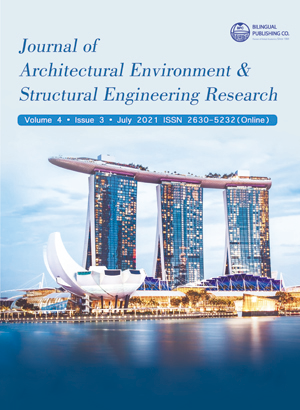-
2127
-
1862
-
1638
-
1597
-
1526
Battery Train Fire Risk on a Steel Warehouse Structure
DOI:
https://doi.org/10.30564/jaeser.v4i3.3327Abstract
Lithium ion battery fire hazard has been well-documented in a variety of applications. Recently, battery train technology has been introduced as a clean energy concept for railway. In the case of heavy locomotives such as trains, the massive collection of battery stacks required to meet energy demands may pose a significant hazard. The objective of this paper is to review the risk evaluation processes for train fires and investigate the propagation of lithium ion battery fire to a neighboring steel warehouse structure at a rail repair shop through a case study. The methodology of the analyses conducted include a Monte Carlo-based dynamic modeling of fire propagation potentials, an expert-based fire impact analysis, and a finite element (FE) nonlinear fire analysis on the structural frame. The case study is presented as a demonstration of a holistic fire risk analysis for the lithium ion battery fire and results indicate that significant battery fire mitigations strategies should be considered.
Keywords:
Lithium ion battery, Train fire, Propagation, Structural safetyReferences
[1] Wang, Q.; Ping, P.; Zhao, X.; Chu, G.; Sun, J.; Chen, C., Thermal Runaway Caused Fire and Explosion of Lithium Ion Battery [J], Journal of Power Sources, 2012, 208: 210-224.
[2] Long, Jr.; R.T., Sutula, J.A.; Kahn, M.J., Flammability of Cartoned Lithium Ion Batteries, the Fire Protection Research Foundation [M], Springer, New York, 2014.
[3] Larsson, F.; Anderson, J.; Andersson, P.; Mellander, B.E., Thermal Modelling of Cell-to-Cell Fire Propagation and Cascading Thermal Runaway Failure Effects for Lithium-Ion Battery Cells and Modules Using Fire Walls [J], Journal of the Electrochemical Society, 2016, 163(14): A2854-A2865.
[4] Blum, A.F.; Long, Jr. R.T., Fire Hazard Assessment of Lithium Ion Battery Energy Storage Systems [M], Springer, New York, 2016.
[5] Cook, D.; Stewart, I., On Board Electrification and Near Zero Emissions for Regional Rail [C], Steel Wheels, September 2014.
[6] ABC 13, Loud boom' heard after train fire near downtown Houston [N], ABC Eyewitness News, https://abc13.com/train-fire-hfd-houston-downtown/1908896/, 2017, last accessed 5/3/2020.
[7] Wang, L.; Zhao, T.; Chen, S.; Cook, D., An Inductive Power Transfer System Design for Rail Applications [C], 2018 IEEE Transportation Electrification Conference and Expo (ITEC), 2018-06: p.84-89, 2018.
[8] APTA, Recommended practice for Transit Bus Fire/ Thermal Incident Investigation [S], APTA BTS-BSRP-004-08, 2009.
[9] APTA, Recommended practice for Transit Bus Electrical System Requirements Related to Fire Safety [S], APTA BTS-BS-RP-002-07, 2009.
[10] APTA, Recommended Practice for Installation of Transit Vehicle Fire Protection Systems [S], APTA BTS-BS-RP-003-08, 2009.
[11] APTA, Recommended practice for Fire Safety Analysis of Existing Passenger Rail Equipment [S], APTA BTS-BS-RP-005-00, 2009.
[12] APTA, Recommended practice for Fire Detection System Inspection and Testing [S], APTA RTSC-S-042-03, 2009.
[13] NFPA, Standard for Fixed Guideway Transit and Passenger Rail Systems [S], NFPA-130, National Fire Protection Association, Washington, D.C, 2020.
[14] IBC, International Building Code [S], International Code Council, Washington, D.C. ISO 834-11:2014, International Organization for Standardization, Mar. 2014, 2018 edition, www.iso.org/standard/57595. html.
[15] ASTM, Standard Test Methods for Fire Tests of Building Construction and Materials [S], ASTM-E119, American Society of Testing and Materials, ASTM International, West Conshohocken, PA, 2019.
[16] Salvati, L.; Ferrara, A., Validation of MEDALUS Fire Risk Index using Forest Fires Statistics through a Multivariate Approach [J], Ecological Indicators, 2015, 48, 365-369.
[17] Von Neumann, J., The Theory of Self-Reproducing Automata [M], University of Illinois Press, Urbana, IL, 1966.
[18] Shiflet, A.; Shiflet, G., Introduction to Computational Science: Modeling and Simulation for the Sciences [M]. Princeton: Princeton University Press, 2006.
[19] MBMA, Fire Resistance Design Guide for Metal Buildings Systems [S], Manual. Metal Building Manufacturers Association, Ohio, 2010.
[20] MBMA, Metal Building Systems Manual [S], Handbook. Metal Building Manufacturers Association, Ohio, 2018.
[21] MBMA, Seismic Design Guide for Metal Building Systems [S], Metal Building Manufacturers Association, Third Edition. Ohio, 2018.
[22] AISC, Steel Construction Manual [S], American Institute of Steel Construction, 15th Edition. Chicago, 2017.
[23] Haehler, Richard. Steel Design Guide 25: Frame Design Using Web-Tapered Members [S]. Steel Design Guide Series Number 25, AISC 2011.
[24] Abaqus, User’s Manuel [M], Abaqus Inc., Johnston, RI, 2018.
[25] ASCE/SEI, ASCE Standard 7-16 Minimum Design Loads and Associated Criteria for Buildings and Other Structures[S], American Society of Civil Engineers, Virginia, 2016.
[26] EN 1993-1-1, Eurocode 3: Design of Steel Structures - Part 1-2: General rules – Structural Fire Design [S]. Brussels: Comité Européen de Normalisation, 2005.
[27] EN 1991-1-2, Eurocode 1: Actions on Structures - Part 1-2: General Actions - Actions on Structures Exposed to Fire [S]. Brussels: Comité Européen de Normalisation, 2009.




 Jasmine Mira
Jasmine Mira





